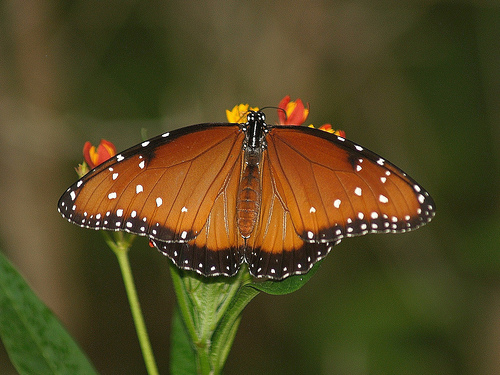
Danaus gilippus (Danaus gilippus)
Phylum — arthropoda
Class — insecta
Order — lepidoptera
Family — nymphalidae
Genus – danaus
Appearance
In the larval stage, Danaus gilippus is a bluish white, with a reddish-brown underside. It has three pairs of black, fleshy tentacles—one is on the head, one is on the second thoracic segment and one is on the eighth abdominal segment — but lack spines. When mature, the caterpillar is brown with purplish prolegs. The caterpillar has been observed in the following transverse stripes: blue, green, yellow, white, and blackish brown. The head is black with white rings. There is no hair on the body of the caterpillar.
Danaus gilippus resembles its close relative the Monarch butterfly (Danaus plexippus) in various ways, but is smaller and the ground color of the wings is a darker brown. It has an average wingspan of 3.1 inches (7.9 cm) to 3.3 inches (8.4 cm). The forewings are long, greatly produced at the apex, and have a triangular outline. The hindwings are well rounded and smaller than the forewing. Black veins with white borders appear on the entire length of the hindwing while the forewing is not bordered with black on its inner margin. The light spots on the apex of the forewings are whiter and patterned differently than those of the Monarch as well.
Habitat
Danaus gilippus belongs to a family (Danaidae) that is common to both New and Old Worlds, specifically found throughout the tropics and into the temperate regions of the Americas, Asia, and Africa.
Behavior
It demonstrates daily activity. The flight is slow. Butterflies are poisonous. The poison accumulates from the plants that the caterpillars feed on. Butterflies overwinter in the south of their range.
Adults roost communally. Danaus gilippus has multiple generations per year.
Diet
Caterpillar hosts – milkweeds and milkweed vines. Butterflies feed on nectar.
Reproduction
For their reproduction you need a mesh cage with a size of 50 x 50 x 70 cm. Females lay small white eggs one at a time on larval host plants, usually members of the milkweed subfamily Asclepiadoideae. The incubation period is 3-5 days. It is better to incubate the eggs separately, because young caterpillars can eat the eggs. It is better to keep the caterpillars in mesh cages for 6-8 insects and provide them with a large amount of food. Otherwise, the caterpillars can eat each other. In the cage, you need to place a branch of the forage plant. Forage plants should be replaced every 3-4 days. The temperature is 22-25 oC at the humidity of 60-70%. The pupa is relatively short and thick, tapering rapidly at the end of the abdomen. It is pale green, rarely pale pink, and is frequently ornamented with golden spots. A black transverse band edged with gold is on the abdomen. Below this black abdominal band lies another one in blue. The pupa stage lasts 7-10 days.
In captivity
The mesh terrarium with a size of 50 × 50 × 70 mm is suitable for keeping butterflies. Room temperature is necessary. Daylight time is 12 hours. You can feed the butterflies with an overripe banana or give them a syrup of honey diluted with boiled water in a ratio of 1:10.
 Russian
Russian
 English
English























